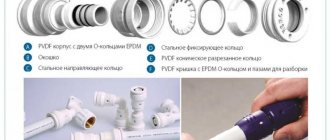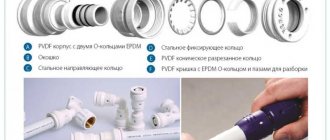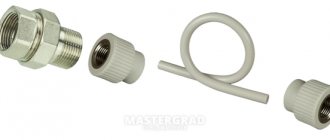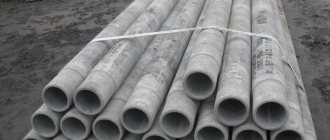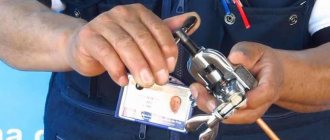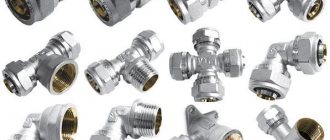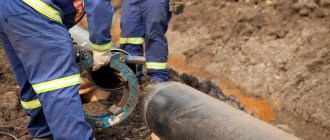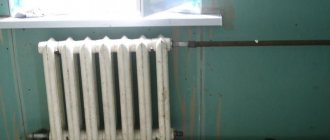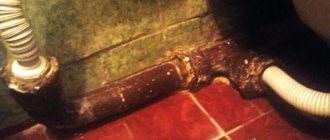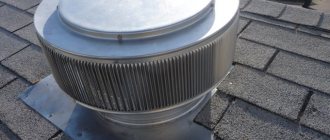In machines for transmitting motion from one mechanism to another, designed as an independent assembly unit (gearbox, variator, engine, etc.), devices are used that connect input and output shafts and are called couplings.
When connecting shafts, couplings can perform other functions:
- connect and disconnect shafts;
- protect mechanisms from breakdowns;
- compensate for mismatch of axes in height and angle;
- absorb vibrations and shocks;
- work with mechanisms with changing peripheral speed, etc.
Reference and other technical literature, as well as catalogs, present in detail the technical parameters of couplings depending on the required properties and transmitted load, structural elements and technical requirements that must be met during installation and operation of couplings.
Therefore, when designing mechanical drive devices and mechanisms, there is rarely a need to develop coupling designs. The task in most cases comes down to selecting a coupling in accordance with the technical requirements.
The main indicator when choosing a coupling is the nominal diameter of the shafts being connected. Then, after selecting the coupling, it may be necessary to check it, which involves determining the design torque, speed and operating conditions, as well as, if necessary, the strength of the connecting parts.
The main characteristic when selecting a coupling is T - the torque (nominal) transmitted by the coupling, Trasch - the moment that takes into account the most severe conditions of its loading and is called design torque , and [T] - the permissible torque specified in the catalog:
where Т=P/ω – torque transmitted by the coupling in steady state (nominal torque), determined by power P and angular velocity ω; k – coefficient of dynamism or operating mode (overload), taking into account additional dynamic loads on the coupling; its value depends on the type of drive motor and the purpose of the working machine. For electric motor drive the following is taken: at a quiet load k=1.15…1.4; at variable load k=1.5…2; at shock load k=2.5…3.
Taking into account inertial masses:
where l1 and l2 are the moments of inertia of the rotating masses of the drive and driven shafts with the parts mounted on them, aligned with the axis of the shaft on which the coupling is installed; Tnom – rated torque.
Instead of the moment of inertia for couplings, a flywheel moment can be specified:
where G is the weight of the rotating parts on the shaft, N; D – diameter of the circle of rotating masses (flywheel rim), m; g=9.81 m/s2.
With a constant direction of rotation and moderately loaded shafts (σ ≈ 15 MPa), coupling halves are installed at the ends of the shafts along transitional fits (H7/m6, H7/k6). For reverse operation, as well as for heavily loaded shafts (σ>15 MPa), interference fits are used. With such a fit of the coupling, problems may arise during dismantling. Therefore, it is advisable for couplings intended to operate with heavy loads to use a taper fit on the ends of the shafts, in which it is possible to create a significant interference in the connection and ensure the exact radial and angular position of the coupling half relative to the shaft.
Clutch - what is it, purpose, features
A plumbing coupling is a special element for connecting pipe sections in difficult sections of the pipeline route. It is used both for laying a new highway and for repairing an existing one. In the standard version, the coupling looks like a piece of pipe, the edges of which, depending on the method of fastening, can be equipped with internal or external threads. By design, it can be straight, rotary, as well as for a triple or quadruple connection, and by structure - monolithic or composite. It is made of various materials - just like the pipes for which it is used for joining.
The main purpose of couplings is a quick, reliable, safe and durable connection of pipe sections into a single pipeline. This method does not require the use of special equipment and complex technologies, such as electric welding. This type of docking can be used in a variety of cases. In everyday life, they are used to install both water supply and sewerage, heating and drainage systems.
Joining a polyethylene pipe with an electric welded coupling Source sgrupp.ru
The type of fastening of the device directly depends on the material:
- Metal - carving.
- Plastic and polymer – soldering.
- Metal-plastic – compression method.
In addition, there are more modern push couplings. The method of joining them is alternative to the traditional compression-crimp method - the pipe is simply inserted into the product until a characteristic click occurs.
Compared to traditional methods, the coupling of pipes has the following number of advantages:
- Ease and high speed of the docking procedure.
- Minimum weight.
- Wide variety in shape, structure and material.
- Availability.
- Possibility of quick dismantling (for threaded connections).
- Versatility in use.
- Resistance to loads.
- Optimal cost.
- Long service life.
- Reliability.
The disadvantages of such devices may appear due to the specific operating conditions. For example, a connection may become loose and leak due to vibration. Also, some types of materials quickly deteriorate under the influence of temperature changes.
Threaded coupling device Source gidroguru.com
Types of couplings
Couplings are special structures that allow you to achieve tightness at the joints of a pipeline system without compromising the overall integrity of the system. As the main material for their manufacture, only those that have increased resistance to various types of aggressive influences (ferrous and non-ferrous metals, plastic, etc.) are used.
Modern manufacturers offer a huge selection of technical solutions that allow installation of couplings in a short time, in the most inaccessible places, quickly and efficiently. Such products are most widely used in such industries as construction, shipbuilding, mining and oil production, cleaning systems, etc.
Structurally, they are cylindrical plastic or metal products made of brass, cast iron, and steel alloys. Based on the nature of connection of products, the following types of couplings are distinguished:
- threaded ones are sections of pipe in which an internal thread is cut (it can be either over the entire surface of the pipe or on both sides of 5-6 threads);
- used when connecting pipes to increase length without the use of welding or special equipment;
There is a division of this pipeline fittings into simple connecting and transitional ones. In the first case, the diameter of the connection at the inlet and outlet of the pipeline will be the same, in the second it will allow it to be changed, which is very often used during the construction of various types of water supply lines.
Combined products have also become widespread. They differ in that they have the same internal thread, but at the same time, installing couplings of a similar design allows you to easily and reliably connect pipes made of different materials (for example, pipes made of polypropylene and steel).
An “American” coupling is also used - a fitting with a union nut, which can have an internal or external thread. It is used mainly when it is necessary to connect two polypropylene pipes with the possibility of their subsequent connection and disconnection from each other.
The most popular models of couplings
When purchasing from ArmProf, you can be confident in the quality of the products you purchase, as well as the service you receive before and after the purchase.
Did you like the article? Tell your friends
Varieties by design and purpose
According to the type of design and purpose, couplings are divided into 2 main types:
- Connecting.
Classified into 2 categories:
- Pipe-to-pipe type. Designed for joining sections of equal diameter.
- Transitional. Used to connect pipes of various diameters.
Both types are used for assembling one-piece or collapsible pipelines. In the first case, a glued or welded model is used for installation, in the second - a threaded one. In this case, one of the prerequisites for creating a tight, reliable connection is that the type of material of the pipe matches the fitting.
- Combined.
Combined type couplings are used to connect pipes made of different materials. Moreover, they are divided into the following subtypes:
- With internal thread. Used for plumbing and heating systems.
- With external thread. The open part with threaded thread allows for more convenient installation of pipes. As a rule, they have a wide variety of sizes.
- Detachable type or “American”. Makes it possible to connect and disconnect both hard and soft types of pipelines.
Connecting a plastic pipe with a detachable coupling Source stroy-podskazka.ru
Note! When selecting a coupling for a specific application, it is critical that it be made of a material similar to the type of pipe being connected. Otherwise, the connection will not be reliable and will weaken or completely collapse over time.
Couplings for copper pipes
Connecting elements for pipelines made of copper material are distinguished by their reliability. One of the most reliable and durable types of connections. In addition, it is a fairly prestigious option and, accordingly, this is reflected in its price.
For copper pipes, couplings made of the same material are most often used
Copper fittings are more expensive than other fittings. There are the following types of couplings for copper pipes:
- threaded fittings;
- compression;
- capillary
- press fittings.
It is very important to remember that when connecting parts of copper pipelines, you should always use fittings made of the same material. This is a necessary rule. In this case, the copper pipeline will last a long time without failure of its elements. Couplings made from other materials are used only when necessary, for example for temporary pipelines. The coupling method is the most popular type of connection. They have a huge number of types and types according to the method of fastening, the shape and features of application, which allows you to make any types of connections necessary in the installation of pipelines. In order to choose the part you need, it is worth considering a number of important indicators: the material of the pipes to be connected, diameter, wall thickness, temperature of the transported medium, length and shape of the future structure. Taking into account all the above indicators, you can choose the ideal connection option that will serve you for a long time and with high quality. Source: information portal trubamaster.ru
Varieties by material
Based on the type of material of the pipes being connected, couplings are divided into the following types:
- Steel.
- Cast iron.
- Copper.
- Plastic and polymer.
Let's look at the features of each of them in more detail.
For steel pipes
Steel water pipes are most popular in private households. Therefore, fittings of the type in question are also very common for them. They are divided into two main types:
- Threaded.
They are essentially a steel cylinder with threads on the inside. Pipe installation is carried out by screwing on both sides of the coupling. The main advantage of such a joint is high mechanical strength, and therefore reliability and durability. However, there is also a significant drawback - due to susceptibility to corrosion, the threads can rust and become permanent.
Steel threaded couplings Source prom.st
See also: Catalog of companies that specialize in engineering systems (heating, water supply, sewerage and others) and related work
This is especially true for cold water pipes. The constantly formed condensate slowly but surely contributes to corrosion processes. This can be avoided if, instead of purely steel products, analogues made of brass or cast iron are used. Their advantage is better protection against rust, ease of installation, versatility and affordable cost.
- Compression.
It is intended primarily for cases where the connected sections of the pipeline do not have a thread, or it is damaged, or it is not possible to cut it. When properly installed, a compression coupling for a steel pipe allows you to achieve a high degree of joint tightness.
Their characteristic feature is the great variability of combinations of connections made - internal or external threads, the possibility of joining pipeline sections of different materials and diameters, as well as connecting taps, valves and other components.
Main advantages:
- Creating a detachable connection that, if necessary, allows you to easily replace any element.
- Joining metal pipes without threads.
- Versatility.
Metal compression couplings Source alicdn.com
However, they also have disadvantages - during installation, preliminary cleaning of the edges from rust or paint is required. In addition, it is impossible to create the most durable joint based on them. Therefore, in most cases they are used for temporary connections.
Recommendation! Compression fittings are recommended for use in the repair of old pipelines, where the use of threading or electric welding is unacceptable due to further destruction of the material.
For cast iron pipes
Pipelines based on cast iron have still not lost their relevance when arranging a private autonomous sewage system - they are strong, durable and not subject to corrosion. However, due to the specifics of the material, it is best to join such metal pipes using the following couplings:
- Sliding. Hidden technology is used for installation. Disconnection will no longer be possible.
- Rolled for repair. Consist of two parts with a rubber gasket inside. Connected using clamps. They are used for sections of the highway that require frequent repairs.
- Plastic. They differ from others in that they can be used repeatedly.
Roll-type coupling made of cast iron for pipeline repair Source gvk.ru
Rubber seals are well suited for joining cast iron pipes, as well as the time-tested method of joining by hammering.
For copper pipes
Couplings specifically designed for joining copper pipes are the most reliable, durable and strong, but at the same time they are more expensive compared to analogues. According to installation features, they are divided into 4 main types:
- On the thread.
- Compression.
- Capillary.
- Press fittings.
A prerequisite for long-term trouble-free operation of copper pipelines is the copper base of the fitting. Couplings made from other materials can also be used, but only as a temporary alternative until suitable copper connectors can be installed.
Copper coupling for connecting pipes Source cloudinary.com
Articulating couplings
Articulated couplings (Fig. 14) are used to connect shafts whose axes are located with a significant offset relative to each other, and during operation the angle of inclination can change.
Rice. 14. Design of a single-joint (a) and paired double-joint (b) coupling
The simplest articulated coupling is a single coupling (Fig. 14, a), consisting of two coupling halves 1 and 2, mounted on the ends of the shafts and connected to them by means of conical pins 3. A cross 4 is installed between the coupling halves, having the shape of a parallelepiped with holes whose axes intersect at right angles. The coupling halves and the cross are connected using pins 5 and bushings 6 with a cylindrical pin 7. The pins have blind holes at the ends, which after assembly are flared, forming a sliding friction hinge.
Single articulated couplings allow shaft axes to be misaligned at an angle of up to 45°.
If it is necessary to increase the angle of inclination between the connected shafts above the limit for a single coupling, use a double articulated coupling (Fig. 14, b) with an intermediate paired fork 8 or two single-joint ones connected in series.
The disadvantage of this coupling is the uneven rotation of the driven shaft.
A double articulated coupling (Fig. 15) with spaced joints is used to ensure rotation of the driven shaft at a constant angular speed, to be able to transmit rotational motion between parallel but offset shafts, and also, if necessary, to transmit rotation between connected shafts that are located at an increased angle.
Rice. 15. Diagram of a double-joint coupling with spaced joints
To allow displacement during operation, the shafts are connected by an articulated double coupling with a telescopic intermediate roller (Fig. 16), i.e., a roller of variable length.
Rice. 16. Diagram of a double-joint coupling with a telescopic joint connection
Articulated couplings are divided into small-sized, transmitting small moments, and large-sized, transmitting medium and large moments. Small-sized articulated couplings, single (Fig. 14, a) and double (Fig. 14, b), are used to connect shafts with a diameter of 8 to 40 mm and a transmitted torque of 11.2 to 1120 N•m.
The hinges of these couplings are formed by insert axles, of which one is long, and the second consists of two short bushings fastened with a rivet. The material of the forks and rivets is 20X case-hardened steel, and the crosspieces and axles are 40X steel.
In transmissions of automobiles, road and other machines, articulated couplings with a spider having joints with needle bearings are widely used.
The verification calculation of articulated couplings consists of determining the pressure on the working surfaces of the hinges and calculating the strength of the forks and crosspieces.
Video description
Video review on the selection and use of compression threadless steel coupling:
With proper installation and compliance with operating conditions, polyethylene fittings will last for more than a dozen years.
- Plastic.
The easiest fittings to use. They are cylinders with sealing material around the edges. For installation, you must first remove the outer chamfer from the pipes to be connected, and then simply put the couplings on them. If necessary, it is allowed to use special glue or sealant.
Important! Fittings based on polyethylene and polypropylene are mostly disposable. The exception is products combined with metal, the body of which does not change its characteristics during installation.
Typical mistakes when installing couplings
Dirty surface
Installation of the connector on the cable is usually carried out in conditions where it is difficult to maintain the cleanliness of the workspace (pits, trenches, industrial premises). However, contaminated surfaces impair the ability to create a tight connection. It is recommended to use protective film coatings, keep tools and consumables clean, and remove dirt from the working surface.
Technology violations
The dimensions of connecting tubes and conductors must meet the requirements of the manufacturer. Otherwise, various defects will gradually manifest themselves. They need to be found in advance and filed with a file, and also processed with a grinder. Protruding fastener elements also need to be sanded. After installation is complete, carefully remove sawdust from the work surface.
Uneven cuff insulation thickness
Uneven thickness of the insulating layer occurs after heat shrinking. To avoid this problem, the surface must be heated equally. Using a bent tin reflector helps solve the issue. This device ensures uniform temperature distribution over the entire surface. As a result, the adhesive composition is heated and distributed evenly, and the thickness of the insulation remains approximately the same.
Leaky couplings
Products mounted on high-voltage power lines have three sealed zones:
- interfacial;
- hull;
- external.
Additional sealants are used to shrink the outer belts. They are used to process joints. After heat treatment, the glue should protrude beyond the edges of the joint, creating a barrier against harmful substances. If the glue does not come out, the connection will not be airtight.
Installation features
The reliability and durability of pipe joining is ensured by a technically competent installation procedure. There are the following features of coupling connections of pipelines made of various materials:
- Flange connection.
The method is used for sections of metal pipes of maximum diameter. First one and then the other half of the fitting is mounted alternately on the area to be connected. The connection point is in contact with a ring of elastic material.
Video description
Video instructions for installing the coupling on a polymer pipe:
- Installation of compression elements.
Initially, the fitting is unscrewed so that it can be conveniently placed on the pipes. Also, marks are made on them in advance for the exact location of the joining element. In this case, the surface must be lubricated.
When the coupling is installed and its position relative to the edges is adjusted, the union nut is tightened. The resulting connection is comparable in strength to a welding seam.
- Installation of electric welded couplings.
Installation is carried out according to the following algorithm:
- The surfaces of the joined sections are pre-cleaned and smoothed.
- The coupling is installed on the edges of the segments.
- Next, power is supplied to the contacts from a special device.
- As the element heats up, the plastic melts and is welded under pressure.
After about half an hour, a strong permanent joint is formed.
Installation of heat shrink sleeve
First you need to prepare the cable. The insulating armored shell is removed from its ends, right down to the conductive elements. The insulation from the cores is not removed at this stage. The length of cable cutting is determined by several factors:
- cable brand;
- cross-section, material of the conductor;
- number of cores, as well as other parameters specified in the reference books.
Next, prepare the coupling for installation:
- Place a heat shrink tube on the end of the cable.
- The grounding wire on the connecting and end couplings is secured with a special contact (without further soldering).
- The junction of the jumper with the armored shell is wrapped in sealing tape.
- For grounding jumpers, copper conductors with a 16 mm cross-section are used. If the cross-section of the cores is 120–240 sq. mm, install a 25 mm jumper.
- Place heat-shrinkable tubing onto the ends of the remaining cable wires.
- Connect phase conductors and neutral. The connection is made with crimp sleeves or bolts with a removable head.
- The wires are placed in the cells of the frame cassette and closed.
The cassette is joined to an external heat-shrinkable tube. Heating occurs, resulting in complete shrinkage. All connecting elements are available in coupling kits.
Cold shrink cable sleeves are installed in a simpler way. The beginning of the process is the same as in the case of a shrink sleeve. At the final stage, a spring with EPDM silicone is pushed onto the coupling. Next, it is removed, and the silicone fits around the coupling, resulting in an airtight connection.
Video description
Video on how to properly install crimp couplings on metal-plastic pipes:
- Installation of couplings on cast iron pipes
In most cases, the caulked coupling method is used for joining cast iron pipes. To do this, take a coupling with expansion on both sides. After inserting the segments into the socket, the expanded parts are compacted.
For this purpose, special compounds are used - cable, graphite gland, cement mortar or asbestos cement. In this case, filling is carried out only after the pipeline is firmly installed. Otherwise, cracks and depressurization of the joint will occur.
- Installation of couplings on steel pipes.
The joining of steel pipes is preceded by the alignment of the joined edges. Next, markings are made to position the coupling as evenly as possible during installation. After this, the edges of the segments are lubricated. Then, first the fitting is put on one pipe, then on the other. After this, they are finally consolidated and checked.
On a note! Pipelines made of any other suitable materials can also be connected using couplings. For example, ceramics, asbestos cement, etc.
Couplings for cast iron pipes
To connect pipes in cast iron water pipelines, two types of connecting elements are used.
With rubber seal. The principle of operation of this connection is similar in type to the joining of plastic pipelines. Its significant difference is that it is much more massive and, due to its weight, is more difficult to install.
Couplings for connecting pipes for embossing. This type of connection of piping systems has been used for more than 100 years. Its peculiarity is the presence of two bells, which are directed in opposite directions.
The sewer system for discharging wastewater and other substances is installed from pipes made of gray cast iron. This cast iron has increased strength indicators. If all installation nuances are observed, pipelines made of this material can have a service life of up to 50 years. Cast iron pipes are produced with or without sockets. And to combine elements with a smooth surface, the following types of couplings are used:
- Sliding. Installation of this type of coupling is carried out in a hidden way. With such a connection, dismantling is impossible without disconnecting the line.
- Repair roll-up. These couplings consist of two main parts, in which a rubber or plastic gasket is used. In addition, fittings of this type are equipped with special clamps and connectors for connection. They are often installed on problem areas of the pipeline that require frequent repairs.
- Plastic. This type of connecting parts can be used several times. Reusability is the main distinguishing factor of such a coupling.
Couplings with rubber gaskets are more convenient to install than those designed for caulking
Installation of couplings on cast iron pipes
If you need to combine two sections of pipeline with a smooth surface, use a caulked connecting piece. Such connecting elements are made from strong gray cast iron. The expander on such elements is located on both sides.
Installation of the connecting coupling for metal pipes made of cast iron is done by inserting the ends of the pipes into the sockets (all the way). Then the pipe is equipped with an additional seal so that the structure acquires the required strength and reliability. A heel or graphite seal is used as a seal.
If the coupling requires embossing, then this process is carried out with a solution based on cement or an asbestos-cement compound. In this case, the sealing element is completely filled with the solution that is more suitable for a particular case. Important! It is very important to note that filling the joints with mortar should only occur after the pipeline is completely installed. Otherwise, the solution will simply crack and the sealing necessary for the normal functioning of the pipeline will be broken.
Briefly about the main thing
The coupling for connecting sections of pipeline is a straight or angled pipe made of a material corresponding to the pipes being joined. Depending on the application conditions and the characteristics of the pipes, joining can be done by threading, soldering, crimping or compression.
Compared to traditional techniques, connecting pipes with a coupling has a number of advantages - lightness, speed, low weight, variety of shapes, sizes and materials, accessibility, dismantling, versatility, durability, low price, reliability and durability. Disadvantages manifest themselves in specific conditions of use.
According to their design features and purpose, couplings are classified as pipe-to-pipe couplings, transition couplings, or combined couplings. According to their purpose for pipes made of a specific material, they are divided into the following types:
- Steel.
- Copper.
- Cast iron.
- Polymer and plastic.
The installation of couplings in each specific case has its own specifics and must be carried out in compliance with the appropriate technology.
Ratings 0
